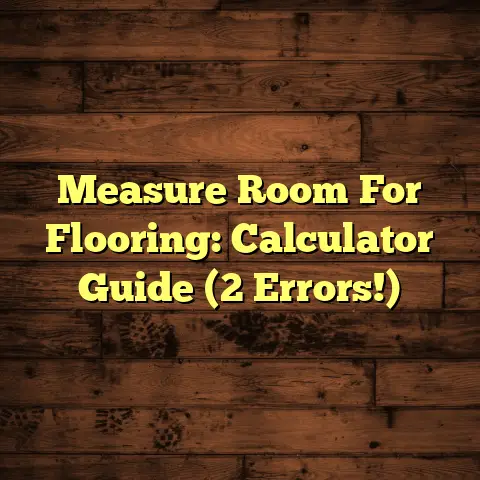How To Lift Tile Flooring? (Explained)
Lifting tile flooring is a task that may seem daunting at first, but with the right preparation and technique, it can be accomplished effectively. To help you through this process, I’ll provide a comprehensive guide based on my personal experiences and knowledge gained over 15 years in the flooring industry. Let’s dive deeper into the various aspects of lifting tile flooring, including detailed steps, tools, challenges, and solutions.
Understanding Tile Flooring
Types of Tile Flooring
Tile flooring comes in various types, each with unique properties and installation methods. Understanding these types can help you determine the best approach for lifting them:
- Ceramic Tiles: These are made from clay and come in a variety of colors, patterns, and finishes. They are known for their durability and water resistance. However, they can be brittle and may crack if not lifted carefully.
- Porcelain Tiles: A denser type of ceramic tile, porcelain is more resistant to moisture and staining. It is often used in high-traffic areas. The lifting process is similar to that of ceramic tiles but may require more effort due to its density.
- Natural Stone Tiles: This category includes materials like granite, marble, and slate. Natural stone tiles offer a unique aesthetic but can be more challenging to lift due to their weight and the potential for cracking.
- Vinyl Tiles: Although not as common as traditional tiles, vinyl tiles can be installed in a manner similar to ceramic tiles. They are generally easier to lift due to their flexibility.
- Glass Tiles: These tiles are often used for decorative purposes and can be fragile. Lifting glass tiles requires extra caution to prevent shattering.
By understanding the type of tile you’re working with, you can adjust your lifting technique accordingly.
Tools and Materials Needed
Having the right tools at hand can significantly ease the tile removal process. Below is an expanded list of tools and materials that I recommend based on my experiences:
- Safety Gear:
- Gloves: Protect your hands from sharp edges and debris.
- Safety Goggles: Shield your eyes from flying shards or dust.
- Dust Mask or Respirator: Prevent inhalation of dust and particles during removal.
- Pry Bar: A flat pry bar helps lift tiles without causing damage. I often keep multiple sizes handy for different applications.
- Chisel: A chisel can break through stubborn adhesive layers. I prefer using a wide chisel for larger areas and a narrower one for tight spots.
- Hammer: A rubber mallet can be useful to gently tap the pry bar or chisel without damaging the tiles.
- Utility Knife: Ideal for cutting through grout lines or adhesive that may still bind the tiles.
- Floor Scraper: After lifting the tiles, a floor scraper helps remove any leftover adhesive from the subfloor.
- Heat Gun: This tool can be useful for softening adhesive that has hardened over time, making it easier to lift tiles.
- Vacuum or Broom: Cleaning up debris is crucial for safety and efficiency.
Step-by-Step Guide to Lifting Tile Flooring
Let’s break down the process into detailed steps, providing insights based on my experiences with various projects:
Step 1: Assess the Area
Before starting any project, assessing the work area is critical. I take time to evaluate how many tiles need to be lifted and check for any underlying issues such as water damage or mold. During one project in an old house in Savannah, I discovered that the subfloor had significant water damage beneath the tile due to a leaky plumbing issue. Identifying such problems early on allowed me to communicate effectively with my client about necessary repairs before proceeding.
Step 2: Prepare the Workspace
Clearing the workspace is essential for both safety and efficiency. I recommend removing all furniture and items from the area. In one instance, I worked in a bathroom where the homeowner had left toiletries on the counter. During removal, I accidentally knocked over a bottle of shampoo, which resulted in a slippery mess on the floor. Lesson learned: ensure everything is cleared before getting started.
Step 3: Score the Grout Lines
Using a utility knife, I carefully score along the grout lines surrounding each tile. This step minimizes damage to adjacent tiles and makes it easier to lift them later. In my experience, scoring deeper grout lines can prevent fractures when lifting tiles, especially with older installations where grout may have hardened.
Step 4: Remove Grout (if necessary)
For thick grout lines, I may use a grout removal tool or oscillating multi-tool equipped with a grout blade. This process can be time-consuming but is crucial for successful tile removal. On one occasion, I had to spend extra hours removing particularly stubborn grout from an old kitchen floor, but it paid off when the tiles came up cleanly without damage.
Step 5: Insert the Pry Bar
Once I’ve scored the grout, I carefully slide the pry bar under the edge of a tile. If it doesn’t lift easily, I may use a hammer to tap it gently for better leverage. A flat pry bar works well for this purpose; however, I have found that using a curved one can sometimes provide better leverage on stubborn tiles.
Step 6: Lift the Tile
With the pry bar in place, I apply upward pressure while wiggling it back and forth to break any remaining adhesion. If you feel resistance, it’s vital not to force it too much as this can lead to cracking. I remember lifting tiles in a commercial space where they were glued down with industrial-strength adhesive; patience was key as I worked through each piece methodically.
Step 7: Repeat as Necessary
I continue this process for each tile until all desired tiles are removed. Keeping track of which tiles I’ve lifted helps maintain organization and ensures I don’t leave any behind.
Step 8: Clean Up
After lifting all tiles, I take time to remove any leftover adhesive using a floor scraper. Depending on the type of adhesive used, this process can vary in difficulty. For example, thinset mortar tends to come off more easily than mastic adhesives, which can cling stubbornly to the subfloor.
Challenges Faced
While lifting tiles can be straightforward, challenges often arise during the process:
- Stubborn Adhesives: Some adhesives hold onto tiles more tenaciously than others. During a project at a restaurant in Charleston, I encountered mastic so strong that it required multiple applications of heat from a heat gun before any progress could be made.
- Fragile Tiles: In another case involving glass tiles, several broke during removal despite my careful approach. This incident highlighted the importance of assessing tile fragility ahead of time and adjusting techniques accordingly.
- Uneven Subfloor: An uneven subfloor can complicate lifting tiles as they may not come up evenly. During one renovation in an older home in Richmond, I found that some tiles were bonded extremely well due to varying levels of moisture absorption in different areas of the subfloor.
Cost Estimation with FloorTally
When planning any flooring project, estimating costs accurately is crucial. I utilize FloorTally for budget estimation because it allows me to input local rates for materials and labor quickly. This tool helped me gauge costs effectively during a recent kitchen renovation project where I needed to account for both tile removal and replacement.
With FloorTally, I was able to generate estimates based on:
- Materials Costs: Including new tiles, grout, adhesive, underlayment (if necessary), and tools.
- Labor Costs: Based on local rates for installation and removal work.
- Disposal Fees: Accounting for any debris generated during tile removal.
Using this software streamlined my planning process and ensured that my clients were fully aware of potential costs upfront, leading to increased trust and satisfaction.
Tips for Successful Tile Removal
Based on my extensive experience in flooring projects, here are some valuable tips for successful tile removal:
- Work Methodically: Rushing can lead to mistakes or injuries; taking your time ensures precision.
- Document Your Progress: Keeping track of which tiles have been lifted helps maintain organization during larger projects.
- Consider Your Replacement Options: If you plan on replacing tiles after removal, research new materials that may offer better durability or style than what was previously installed.
- Use Proper Techniques: Ensure you’re using appropriate lifting techniques based on tile type—this can save time and prevent damage.
- Plan for Cleanup: Allocate time for cleanup after removing tiles; this step is crucial for maintaining safety and efficiency throughout your project.
Maintenance After Tile Removal
Once you’ve successfully lifted the tile flooring, it’s essential to consider what comes next—especially if you’re planning to install new flooring or make repairs:
- Inspect Subflooring: Before installing new flooring, check the condition of your subflooring thoroughly. Look for signs of damage such as rot or mold; addressing these issues upfront will save you time and money down the line.
- Repair Any Damage: If there are cracks or weak spots in your subflooring, now is the time to repair them using appropriate materials like plywood or cement board depending on your new flooring choice.
- Clean Thoroughly: Remove all remnants of adhesive and debris from both the subflooring and surrounding areas before proceeding with installation.
- Consider Underlayment: If your new flooring requires it (e.g., laminate or engineered wood), selecting an appropriate underlayment will improve comfort and reduce noise levels in your space.
- Plan Your Installation Method: Depending on what type of flooring you choose next (tiles, hardwoods, etc.), familiarize yourself with installation techniques specific to that material.
Conclusion
Lifting tile flooring is a manageable task when approached with preparation and care. Throughout my years as a flooring contractor, I’ve encountered various challenges—from stubborn adhesives to fragile tiles—but each experience has taught me valuable lessons that inform my current practices.
By understanding different types of tile flooring, utilizing proper tools and techniques, and planning effectively using resources like FloorTally, anyone can successfully navigate this project.
In conclusion, whether you’re lifting tiles for repair or replacement purposes, having detailed knowledge about techniques and potential pitfalls will empower you to tackle your flooring projects confidently. Remember: preparation is key!





